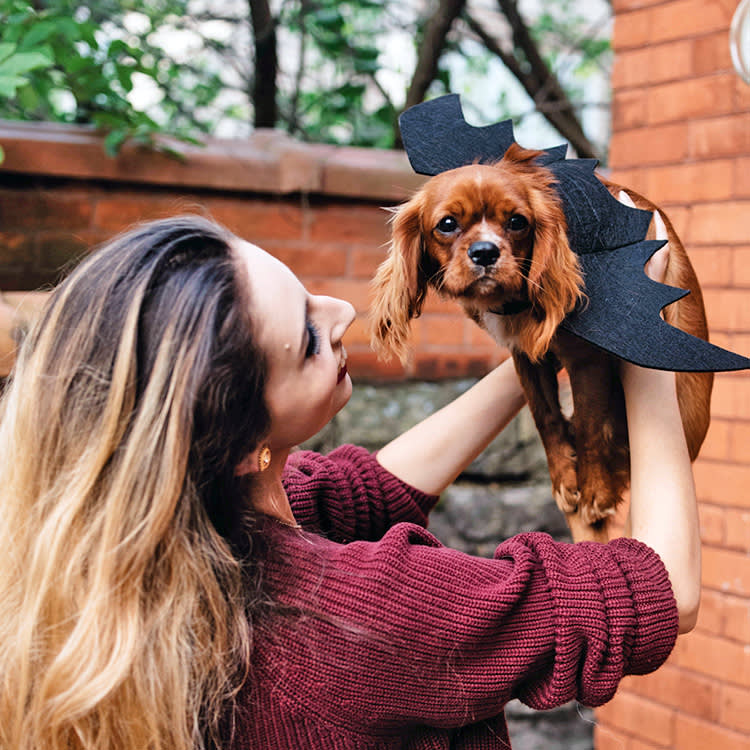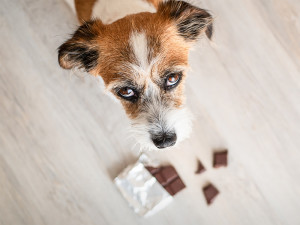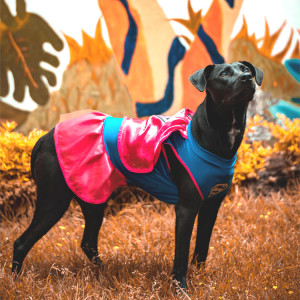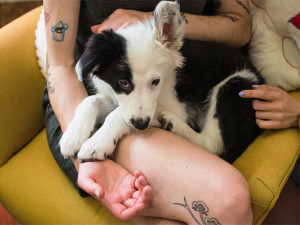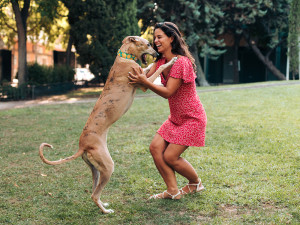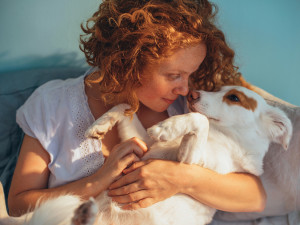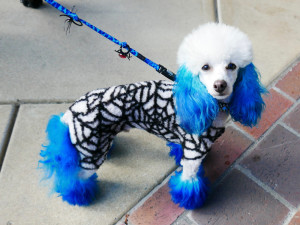7 Surprising Things Dogs Hate About Halloween
This holiday is chock full of triggers that could scare any pooch.
Nothing stresses my dog out more than Halloween night. An anxious pup who already launches into barking fits at the slightest noise in our apartment hallway, for her, this holiday is basically an overflowing candy bag full of triggers. She hates the strangers wandering in and out. She never gets used to the doorbell ringing nonstop. And don’t even get her started on the swarms of people outside when we take her out for her last walk of the night.
“Imagine going for your usual morning walk and suddenly seeing a 30-foot blow-up cat in a yard that wasn’t there yesterday, without having any concept or understanding of Halloween,” Kristi Jones certified dog trainer and owner Mind Your Manners Pet Training, LLC, says. “It’s no wonder dogs can be on edge.”
Trick question: All dogs are perfect! But find out which type is the best fit for you.
So, what’s a sympathetic pet parent to do? Luckily, there are a lot of ways we can prepare our pets for the big night. I asked two experts — Jones and Kirsten Kraljevic, a professional dog trainer with decades of experience — to give me the rundown of everything dogs hate about Halloween, and how best to help them.
Things your dog hates about Halloween
Unfamiliar decorations
Strange objects can be freaky — especially if they light up, move, or make noise. To help your pup stay calm, Jones recommends letting them watch you set everything up. “If you have motion-activated decor, inside or outside, turn off the motion detector when not in use so your dog isn’t startled every time they just try to walk to the water bowl or go outside,” Jones says. Let your dogs check out any new objects on their own terms.
How much do you spend on your pet per year?
And as for all of the scary lawn decorations around the neighborhood? Don’t force your dogs to interact with anything they don’t seem to like; instead, let them investigate new objects during walks on their own terms wherever it’s safe to do so. Jones recommends giving curious dogs about five to 10 seconds to check out new sights. “After about 10 seconds, if they aren’t ready to move on themselves, they may be mentally stuck, like a deer caught in headlights, and guiding them away with a treat may be helpful,” she says.
Crowds of trick-or-treaters
If your dog is used to long, quiet walks and is afraid of kids, Halloween is tricky. Try walking your dog or taking them out to play earlier in the day, before all the movie monsters and superheroes take to the streets. As Kraljevic puts it, “A tired dog is often a calmer dog.”
This isn’t just about keeping your dog calm; it’s also about safety. Even if they’re microchipped, Jones recommends keeping your dog’s collar on with a tag, or even some painters tape with their name and your contact information. Make sure the contact information on both their tag and microchip is up to date and keep a current photo on hand in case they get lost. As Jones points out, “A picture showing a shaggy dog isn’t very helpful if they’ve just been shaved at the groomer.”
While walking outside during and after Halloween, keep an eye out for loose candy. Jones warns that sugar-free candies and chewing gum contain Xylitol, also known as birch sugar, which, like chocolate, is highly toxic to dogs. If your dog eats any of these sweet treats, consult with your veterinarian or call the ASPCA poison control hotlineopens in new tab.
Strangers approaching the house
Even the most chill and extroverted dogs might find themselves anxious on Halloween night. “Constant foot traffic and strangers coming to the door can make dogs feel like their territory is being invaded, leading to protective or fearful behavior,” Kraljevic says. To your dog, the stranger danger is real.
This holiday is the second-most prolific day (following the Fourth of July) of the year for lost pets for a reason. Joan says: “Even pets who are usually very friendly with people can get spooked by kids who don’t look or act as they normally do, and sometimes, they may bolt out of the door and become disoriented and scared very quickly.” That’s why it’s crucial to keep their collar and tags on at all times.
The doorbell
If repeated doorbell ringing makes your dog anxious, take steps before and after the actual night of Halloween to help them cope.
Before the big day, try teaching your dog some door etiquette by asking a friend or relative to ring the doorbell while you reward your dog for staying calm or retreating to a quiet place, Kraljevic says. And on actual Halloween night, Jones recommends setting up a quiet spot or room in the house with familiar bedding and lots of toys. Leave a noisy distraction like the TV or radio on to mask the unfamiliar sounds.
Depending on how bad your dog’s doorbell fear is (and how good the weather is), you might also consider sitting outside to greet trick-or-treaters and pre-empt the doorbell. As an alternative, Jones suggests keeping an eye out for approaching trick-or-treaters so you can open the door for them before they ring the bell.
Unusual noises
In terms of noise, it’s not just the doorbell you have to worry about. From fireworks to electronic decorations to nearby house parties, Halloween spawns all sorts of sounds that can make a dog nervous. Just like with the doorbell, it can help to create a comfy, cozy, peaceful spot where your dog can ride out the night.
Whatever you do, both experts advise against leaving your dog outside unattended or off leash, even in a fenced yard. Sounds like fireworks can cause them to panic and run away, even by digging under a fence. Plus, Jones points out, “people can enjoy playing pranks and you don’t want your dog to be a target of some trickster with less than good intentions.”
Seeing you in costumes
Your Morticia Addams costume might slay, but sadly, your dogs won’t get the reference. In fact, there’s a good chance that the sight of you in a long wig and unfamiliar clothes might just freak them out. The solution? It’s time for a “get ready with me” (GRWM) sesh.
“I always suggest that people let their dogs see them dress up or dress up in stages,” Jones says. “Don’t just suddenly pop out in full costume.”
Kraljevic echoes this suggestion and adds that it can also be helpful to reward dogs for “calm exploratory behavior” while they check out your weird outfit. Just don’t take it personally if they don’t give you the compliments you deserve.
Wearing costumes themselves
If seeing you in weird clothes might freak your dog out, there’s a non-zero chance that they don’t want to wear a costume, either.
“While we find dogs dressed in costumes cute and fun, many dogs are very uncomfortable with wearing clothes,” Jones says. “If you really want to dress them up, make sure that costumes do not restrict their movement or their breathing at all, or have pieces that can be chewed off easily. Get them acclimated to wearing the costume gradually, using lots of treats.”
We all want our dog to win Best Dressed at the office Halloween party, but no prize is worth making them miserable.
Bright or flashing lights
Humans love shiny objects, but your dog might not be as wild about the light-up decorations, the glow sticks, and the flashlights that can go hand-in-hand with Halloween. Ahead of the holiday, Kraljevic recommends trying desensitization training to help lessen your dog’s stress around whatever triggers might set them off.
“Ideally you would start desensitization training for Halloween way ahead of Halloween,” Kraljevic says. “Desensitization training relies on Halloween-related stimuli being introduced gradually, taking weeks if not months.”
Whatever the flashy thing might be, introduce it to your dog slowly and offer plenty of treats and praise for neutral or happy responses.
Changes in routine
Like many of us, dogs are creatures of habit, so any shift in their usual routines, like eating and walking times, can create stress, Kraljevic says. Try to keep your activities as ordinary as possible and minimize disruptions.
If your dog appears stressed, Jones advises that activities like licking, chewing, and sniffing can help reduce stress hormones. She recommends distractors like long-acting chews to help them calm down after stressful events. Kraljevic also suggests enrichment activities like puzzle toys to keep their attention occupied.
Keep your responses soothing but not over-the-top; making too much of a fuss about your dog’s anxiety can unintentionally reinforce it, Kraljevic warns. “If you’re outside, and your dog is visibly stressed, calmly remove them from the stressful situation and return home or to a quieter area.”
Should I give my dog medication for Halloween stress?
Most dogs can make it through Halloween without medication, Jones says, but each dog is different. If you’re considering looking into medication to help your dog manage isolated, stressful nights like Halloween, consult your vet in advance to give yourself time to try out the medication, see if it works, and adjust the dosage (with help from your vet) if needed.
If anti-anxiety medications seem too extreme, you can also speak with your vet about calming supplements or pheromone diffusers.
Halloween can be a busy, logistics-heavy holiday, but follow these tips, and you and your dog will be dancing to “Monster Mash” in no time.
